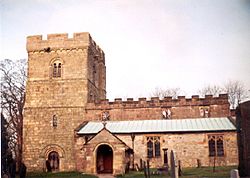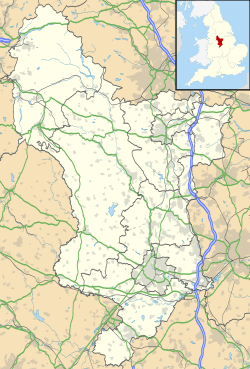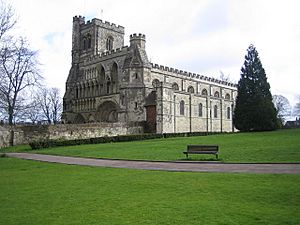Bradbourne Priory facts for kids

All Saints Parish Church, Bradbourne
|
|
| Monastery information | |
|---|---|
| Other names | Later, All Saints Parish Church |
| Order | Presumed Augustinian |
| Mother house | Dunstable Priory |
| Diocese | Diocese of Lichfield |
| Controlled churches | Tissington, Brassington and Ballidon |
| People | |
| Founder(s) | Unknown |
| Site | |
| Location | Bradbourne, Derbyshire, England, United Kingdom. |
| Coordinates | 53°4′17″N 1°41′27″W / 53.07139°N 1.69083°W |
| Visible remains | Part of present Parish Church |
Bradbourne Priory was a special kind of monastery in Bradbourne, Derbyshire, England. Monasteries are places where monks or nuns live and dedicate their lives to religious practices. This priory was connected to a larger monastery called Dunstable Priory.
The priory at Bradbourne included a main church and a community of religious people. It also looked after three smaller churches in nearby villages: Tissington, Brassington, and Ballidon. Today, the main priory church is known as All Saints Parish Church. It is a very old and important building, listed as Grade I.
Contents
What the Church Looks Like
There has been a church on this spot for a very long time. People believe it dates back to Saxon times, which was over 1,000 years ago! In the churchyard, you can see the Bradbourne Cross. This is an old stone cross from the 8th century. It shows a picture of the crucifixion. It was once broken but has now been put back together.
A church was mentioned here in the Domesday Book of 1086. This was a big survey of England ordered by William the Conqueror. A new church was built around the early 1100s. This Norman church was quite large. Its tower was bigger than most towers built at that time.
Some parts of the Norman church are still there today. The tower and the south porch are mostly unchanged. The church was likely rebuilt or changed again in the early 1200s. The part of the church called the chancel was built a bit later, around 1320. The church is dedicated to All Saints. It has a main area (nave), a side aisle, a porch, a chancel, and a tower at the west end.
Next to the church is Bradbourne Hall. People think this hall was built on top of the old priory buildings or the priest's house.
A Look at the Priory's History
Early Days of the Church
This area has been important for religious reasons since at least Saxon times. New churches were built here before the Domesday Book was written. More building work happened in the early 1100s and again in the early 1200s. We don't know for sure if these early churches were priories or just regular parish churches.
The 1200s: Connecting to Dunstable
In 1205, a man named Sir Geoffrey de Cauceis sold the land of Bradbourne. But he kept the church separate. He gave the church and its lands to Dunstable Priory in Bedfordshire. This meant Bradbourne became a "cell" or a smaller part of Dunstable Priory. The money earned by Bradbourne Priory helped support three canons (religious leaders) at Dunstable.
In 1214, the leader of Bradbourne Priory went to court in Rome. He wanted to remove some of the priests. He claimed that some priests were related to earlier priests, which was not allowed. He also made accusations about other unsuitable behavior.
In 1243, over 800 sheep belonging to the priory died. But by 1284, the priory was doing better. Records show it owned 1,200 cattle and sheep!
In 1278, the Bishop of Coventry and Lichfield officially recognized Bradbourne Priory. This happened after a payment was made by the smaller churches connected to Bradbourne.
By 1291, the priory was valued at 60 marks (a type of money). But by 1295, Bradbourne Priory was struggling with money. To help, all the wool produced there was used to support the three religious brothers who served the church.
The 1300s: A Court Case and a Big Change
In 1305, the leader of the priory took Roger Bradbourn, the local lord, to court. He accused Roger and others of digging up lead ore from the priory's land. The priory claimed that all the land in the village belonged to the church. The court agreed with the priory. Roger and his family were told they could never disturb the church's land again.
Around 1330, Dunstable Priory asked the Bishop of Coventry and Lichfield for a change. They wanted a regular priest to serve at Bradbourne Church instead of two of their own monks. The bishop agreed. The priory gave some land to the new priest in Tissington. They also built a new house for him.
This new priest would get money from the crops and animals in Tissington. He would also get money from the mills and other church fees. In return, he had to perform all the church services in Bradbourne and its chapels. This change meant Bradbourne stopped being a traditional priory. It became more like a regular parish church, though it was still controlled by Dunstable Priory.
The 1500s: Changes and New Owners
In 1535, a survey called the Valor Ecclesiasticus estimated the church's yearly value. It was about £8 3s 4d. This included money from other religious places.
On September 30, 1554, officials visited Bradbourne. They were sent by King Edward VI. They made a list of all the church items. They took away many items that were considered "superstitious." These included special clothes, altar cloths, cups, bells, and a chalice (a special cup for services).
After the Dissolution of the Monasteries (when King Henry VIII closed many monasteries), the church's ownership changed. It passed to the Cavendish family, who later became the Dukes of Devonshire.
The 1600s: Repairs and Disputes
In 1609, George Buxton bought the old church lands and the right to appoint the priest. He replaced the old priest's house with the current Bradbourne Hall for himself.
By 1627, the church at Bradbourne needed serious repairs. The roof, wood, windows, and bells were all in bad shape. It was estimated to cost about £46 to fix everything. This was a lot of money back then!
In 1629, the churchwardens (people who look after the church) of Bradbourne went to court. They sued people from the nearby village of Atlow. They said it was an old custom for Atlow villagers to pay for repairs to Bradbourne church, but they hadn't been paying. The court decided that the people of Atlow had to pay 5s. 6d. per "oxgang" (about 15 acres of land) each year for repairs. However, they didn't have to pay for any money they owed from the past.



